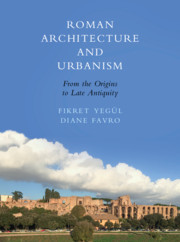Book contents
- Roman Architecture and Urbanism
- Roman Architecture and Urbanism
- Copyright page
- Contents
- Preface and Acknowledgments
- Maps
- Introduction
- 1 Urban Design and Architecture in Rome and Italy during the Republic and the Early Empire
- 2 Temple Architecture of Republican Rome and Italy
- 3 Technology of Building
- 4 Julio-Claudian Architecture in Rome
- 5 Residential Architecture
- 6 Imperial Architecture in Rome from the Flavians through the Antonines
- 7 Architecture and Planning in Italy and the Western Provinces
- 8 Architecture and Planning in North Africa
- 9 Greece under Roman Rule
- 10 Architecture and Planning in Asia Minor
- 11 The Roman Near East
- 12 The Late Empire in Rome and the Provinces
- General Bibliography
- Glossary
- Index
- Plate Section (PDF Only)
- References
6 - Imperial Architecture in Rome from the Flavians through the Antonines
Published online by Cambridge University Press: 21 August 2019
- Roman Architecture and Urbanism
- Roman Architecture and Urbanism
- Copyright page
- Contents
- Preface and Acknowledgments
- Maps
- Introduction
- 1 Urban Design and Architecture in Rome and Italy during the Republic and the Early Empire
- 2 Temple Architecture of Republican Rome and Italy
- 3 Technology of Building
- 4 Julio-Claudian Architecture in Rome
- 5 Residential Architecture
- 6 Imperial Architecture in Rome from the Flavians through the Antonines
- 7 Architecture and Planning in Italy and the Western Provinces
- 8 Architecture and Planning in North Africa
- 9 Greece under Roman Rule
- 10 Architecture and Planning in Asia Minor
- 11 The Roman Near East
- 12 The Late Empire in Rome and the Provinces
- General Bibliography
- Glossary
- Index
- Plate Section (PDF Only)
- References
Summary
The end of Julio-Claudian rule, marked by the violent death of Nero and followed by a year of turmoil and civil war, was uncommonly like its turbulent beginning. In a little over a year, four emperors ascended to the throne, mainly through overt military support. Three of the contenders – Galba, Otho, and Vitellus – ruled only a matter of months before they were dethroned and murdered by legions favoring their own leader for the top job. The fourth, Vespasian, the commander of the army in Palestine, was proclaimed emperor by his troops in 69 ce. At the age of sixty, a seasoned and popular soldier, he was able to bring order and normalcy after a period of struggle, and gained the support of the Senate, the army, and the people. Followed by his two sons, Titus and Domitian, Vespasian established the Flavian dynasty that ruled Rome and her expanding empire until 96 ce, a little over one-quarter of a century.
- Type
- Chapter
- Information
- Roman Architecture and UrbanismFrom the Origins to Late Antiquity, pp. 294 - 408Publisher: Cambridge University PressPrint publication year: 2019



